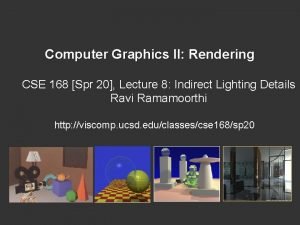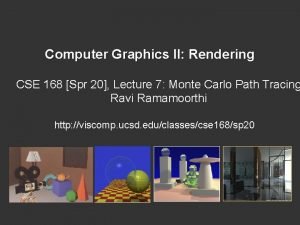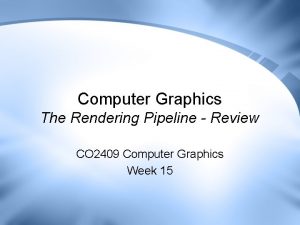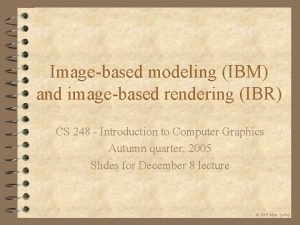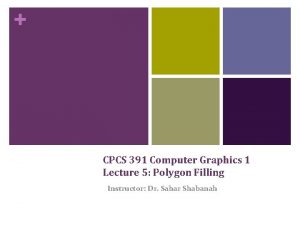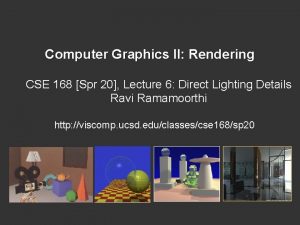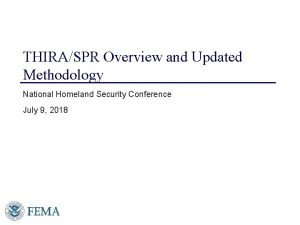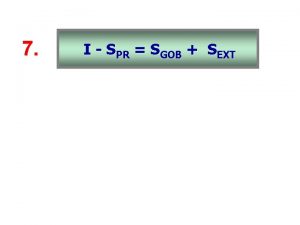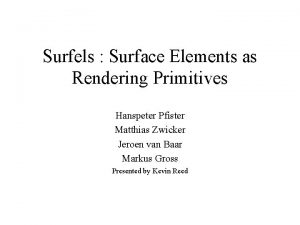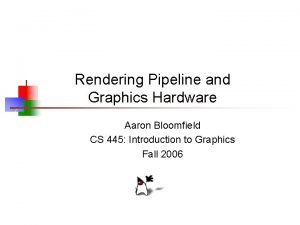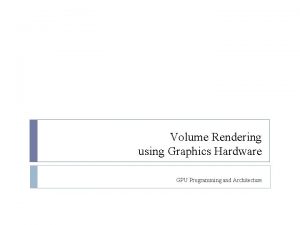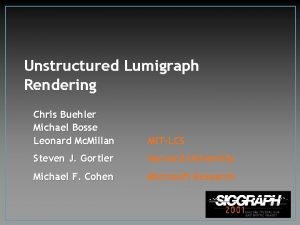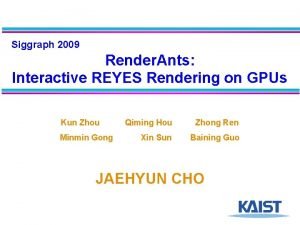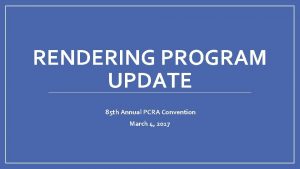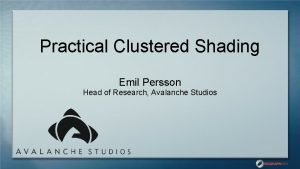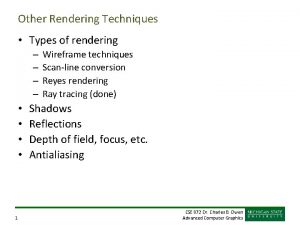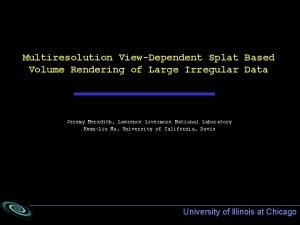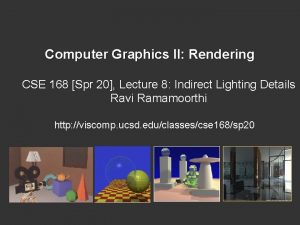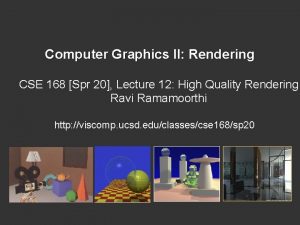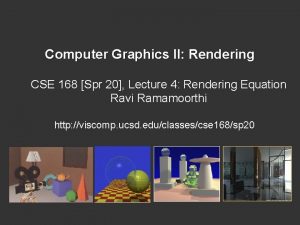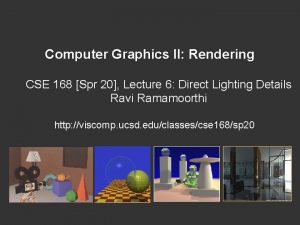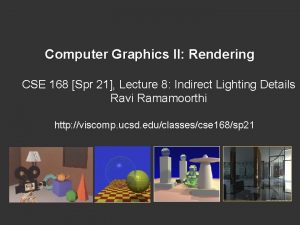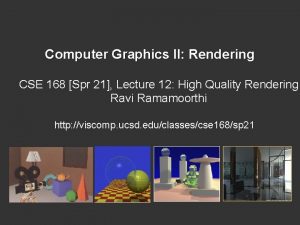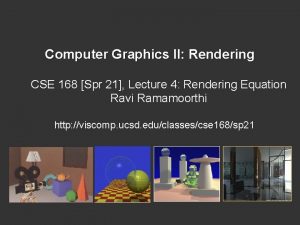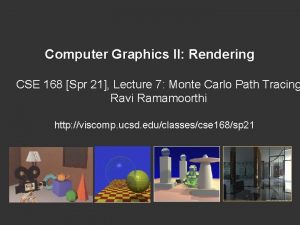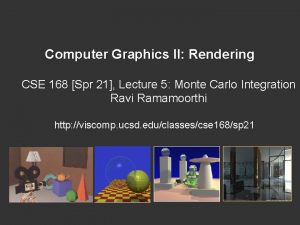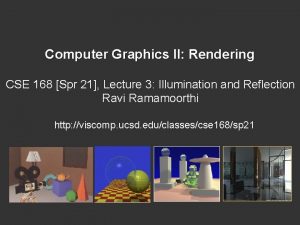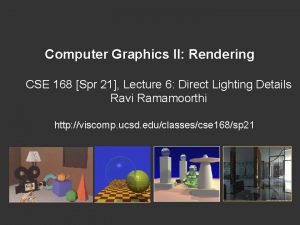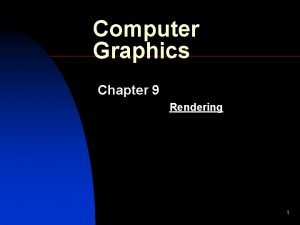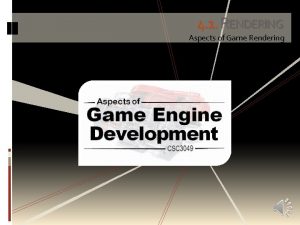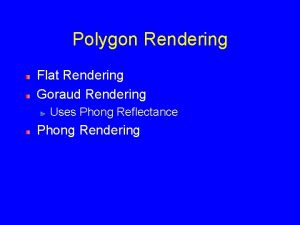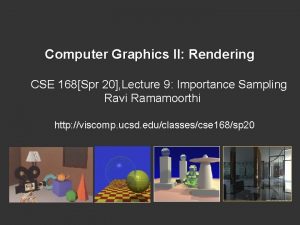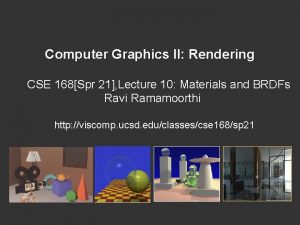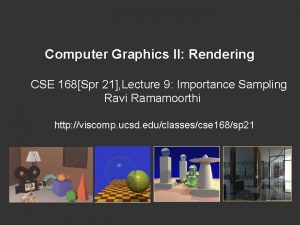Computer Graphics II Rendering CSE 168 Spr 20
![Computer Graphics II: Rendering CSE 168 [Spr 20], Lecture 6: Direct Lighting Details Ravi Computer Graphics II: Rendering CSE 168 [Spr 20], Lecture 6: Direct Lighting Details Ravi](https://slidetodoc.com/presentation_image/f95f17570fe288f1a30abd17c4ba180a/image-1.jpg)








![Analytic Irradiance § Analytic irradiance for a polygon [Baum 89, Arvo 94 -95] § Analytic Irradiance § Analytic irradiance for a polygon [Baum 89, Arvo 94 -95] §](https://slidetodoc.com/presentation_image/f95f17570fe288f1a30abd17c4ba180a/image-10.jpg)
![Analytic Irradiance § Analytic irradiance for a polygon [Baum 89, Arvo 94 -95] § Analytic Irradiance § Analytic irradiance for a polygon [Baum 89, Arvo 94 -95] §](https://slidetodoc.com/presentation_image/f95f17570fe288f1a30abd17c4ba180a/image-11.jpg)
![Analytic Irradiance § Analytic irradiance for a polygon [Baum 89, Arvo 94 -95] § Analytic Irradiance § Analytic irradiance for a polygon [Baum 89, Arvo 94 -95] §](https://slidetodoc.com/presentation_image/f95f17570fe288f1a30abd17c4ba180a/image-12.jpg)


















- Slides: 30
![Computer Graphics II Rendering CSE 168 Spr 20 Lecture 6 Direct Lighting Details Ravi Computer Graphics II: Rendering CSE 168 [Spr 20], Lecture 6: Direct Lighting Details Ravi](https://slidetodoc.com/presentation_image/f95f17570fe288f1a30abd17c4ba180a/image-1.jpg)
Computer Graphics II: Rendering CSE 168 [Spr 20], Lecture 6: Direct Lighting Details Ravi Ramamoorthi http: //viscomp. ucsd. edu/classes/cse 168/sp 20

To Do § Homework 2 (Direct Lighting) due Apr 24 § Assignment is on ed. X edge § START EARLY § This lecture goes through details of direct lighting, visibility, Monte Carlo for the assignment § Ask re any questions

Area Lights § Physically correct (physically no perfect point light) § Can talk in terms of radiance at surface § Enable soft shadows, partial visibility/occlusion § Shoot multiple rays to light source, average § Need proper rendering equation for accurate result § Only direct lighting here, so reflection equation suffices

Example: Soft Shadows

Reflection Equation Reflected Light (Output Image) Emission BRDF Incident Light (from light source) Cosine of Incident angle

Reflection Equation Sum over all light sources Reflected Light (Output Image) Emission BRDF Incident Light (from light source) Cosine of Incident angle

Reflection Equation Replace sum with integral Reflected Light (Output Image) Emission BRDF Incident Light (from light source) Cosine of Incident angle

Reflection Equation As written in assignment (for one pixel) Reflected Light Emission (Outgoing Dirn. Drop spat. Coord. ) BRDF Incident Light (from area light) Cosine of Incident angle (max not explicit hw)

Uniform Polygonal Area Source § Integrate projection of polygon P onto sphere § Assume uniform radiance incident from light Li § Assume no emission (and no occlusion for now) § Nusselt’s analog (wikipedia image) project to (unit hemi)sphere, then circle (unit disk at equator) for cosine term [but only valid for Lambertian, or modulate by BRDF]
![Analytic Irradiance Analytic irradiance for a polygon Baum 89 Arvo 94 95 Analytic Irradiance § Analytic irradiance for a polygon [Baum 89, Arvo 94 -95] §](https://slidetodoc.com/presentation_image/f95f17570fe288f1a30abd17c4ba180a/image-10.jpg)
Analytic Irradiance § Analytic irradiance for a polygon [Baum 89, Arvo 94 -95] § Useful to get precise answer, check Monte Carlo § Define “irradiance vector” [Arvo 94]
![Analytic Irradiance Analytic irradiance for a polygon Baum 89 Arvo 94 95 Analytic Irradiance § Analytic irradiance for a polygon [Baum 89, Arvo 94 -95] §](https://slidetodoc.com/presentation_image/f95f17570fe288f1a30abd17c4ba180a/image-11.jpg)
Analytic Irradiance § Analytic irradiance for a polygon [Baum 89, Arvo 94 -95] § Useful to get precise answer, check Monte Carlo § Define “irradiance vector” [Arvo 94]
![Analytic Irradiance Analytic irradiance for a polygon Baum 89 Arvo 94 95 Analytic Irradiance § Analytic irradiance for a polygon [Baum 89, Arvo 94 -95] §](https://slidetodoc.com/presentation_image/f95f17570fe288f1a30abd17c4ba180a/image-12.jpg)
Analytic Irradiance § Analytic irradiance for a polygon [Baum 89, Arvo 94 -95] § Useful to get precise answer, check Monte Carlo § Define “irradiance vector” [Arvo 94]

Implementing Analytic Irradiance § New parallelogram light quad. Light <a> <ab> <ac> <radiance> § quad. Light 0 0 0 1 1 § Primary rays like ray tracer § Use analytic formula for shading § Add contribs. from all lights § No emission, visibility (yet)

Example (No Noise)

General Direct Lighting § Include (partial) visibility by tracing multiple rays § Include non-Lambertian reflectance (Phong) § Integrate over area light, change area measure

General Direct Lighting § Include (partial) visibility by tracing multiple rays § Include non-Lambertian reflectance (Phong) § Integrate over area light, change area measure

Monte Carlo Solution § Sample area light (two random numbers give x’k) § Random or stratified (compare) § Monte Carlo evaluation of direct lighting (N samples)

Compare to Analytic (no shadows) Number of Samples 1 (Random)

Compare to Analytic (no shadows) Number of Samples 3 (Random)

Compare to Analytic (no shadows) Number of Samples 9 (Random)

Compare to Analytic (no shadows) Number of Samples 9 (Stratified)

Compare to Analytic (no shadows) Analytic

More Complex Scenes § For assignment, render with 5 x 5 stratified § Direct lighting only, turn off recursive raytracing etc

Submission (bias, variance) § Monte Carlo introduces noise § So auto-feedback can’t just pixel difference § Bias is on average how far from (analytic? ) result § Monte Carlo rendering is an unbiased (bias 0) technique § High bias indicates an error in the program § Analytic should be exact (no bias or variance) § Variance is squared pixel error (RMS = stdev) § All Monte Carlo results will have some variance § May differ in variance from our solution § But our bounds are reasonable (too far off = issues? ) § Focus on being correct, not just pretty § Can submit to autofeedback as many times as you want § Scores only suggestive, will grade manually

Submission (bias, variance) § Monte Carlo introduces noise § So auto-feedback can’t just pixel difference § Bias is on average how far from result (close to 0) § Monte Carlo rendering is an unbiased technique § High bias indicates an error in the program § Variance is squared pixel error (RMS = stdev) § May differ in variance from our solution § But our bounds are reasonable (too far off = issues? )

Submission (bias, variance)

Extra: Reducing Variance § Increase bias slightly by evaluating everything except visibility (at center [of stratum], or analytic) § Noise now only from visibility, none otherwise § No noise if no occlusions/shadows § Exact if use analytic formula (to evaluate unshadowed irradiance from each strata) instead of stratum center

Extra: Point Lights § Point lights not physical (but widely used) § How to include in Monte Carlo Rendering? § Units aren’t even same (can’t use radiance) § Power per solid angle, not power per unit area per solid angle § Think of as delta functions (area goes to 0, total radiance integrated over light I = Li A remains same) § No cosine term for light, inverse square falloff, no integral

Extra: Directional Lights § First, assume small angular extent (even subtends an angle of 0. 5 degrees) § If pure directional light (delta function), then fix product (same units as irradiance)

Combining Point, Directional, Area § Small angle, area expressed in radiance Li § Use physical units Wm-2 sr-2 § Point is in intensity Wsr-2 § This is not in same units (e. g. 0… 1) as area lights § Need to normalize by multiplying by an area unit § Point light same intensity as area light: multiply by area § Directional is in irradiance units Wm-2 § This is not in same units (e. g. 0… 1) as area/point lights § Need to normalize by multiplying by solid angle § Directional light same intensity as area light: multiply by average solid angle subtended by area light § Directional same intensity as point: divide by average squared distance to point light, mult by 2 for avg cosine
 168 spr
168 spr Cse 168
Cse 168 Computer graphics pipeline
Computer graphics pipeline Forma urbis
Forma urbis Graphics rendering
Graphics rendering Most of the graphics monitors today operate as
Most of the graphics monitors today operate as Computer graphics chapter 1 ppt
Computer graphics chapter 1 ppt Cse
Cse Spr words
Spr words Spr kontti palkkatuki
Spr kontti palkkatuki Nuorten turvatalo tampere
Nuorten turvatalo tampere Spr hyytymistekijä paketti
Spr hyytymistekijä paketti Gtcs professional update
Gtcs professional update Kylmä koho kompressio spr
Kylmä koho kompressio spr Nicoya spr
Nicoya spr Spr man
Spr man Thira/spr
Thira/spr Gtcs spr
Gtcs spr I spr
I spr Thira spr
Thira spr Teknik arsir bayangan
Teknik arsir bayangan Blue moon rendering tools
Blue moon rendering tools Camera translate
Camera translate High dynamic range rendering
High dynamic range rendering Jerry tessendorf
Jerry tessendorf Christopher buehler
Christopher buehler Reyes rendering
Reyes rendering Photorealistic rendering carlsbad
Photorealistic rendering carlsbad Clustered forward rendering
Clustered forward rendering Shadow rendering techniques
Shadow rendering techniques Splat rendering
Splat rendering
